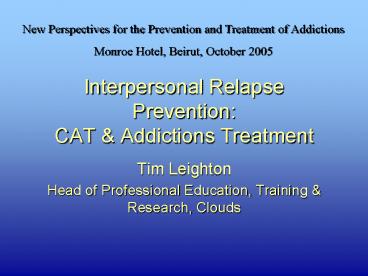Interpersonal Relapse Prevention: CAT - PowerPoint PPT Presentation
1 / 16
Title:
Interpersonal Relapse Prevention: CAT
Description:
Head of Professional Education, Training & Research, Clouds ... The psychodynamic models in which conflicting forces' or agencies' are reified ... – PowerPoint PPT presentation
Number of Views:64
Avg rating:3.0/5.0
Title: Interpersonal Relapse Prevention: CAT
1
Interpersonal Relapse PreventionCAT
Addictions Treatment
New Perspectives for the Prevention and Treatment
of Addictions Monroe Hotel, Beirut, October 2005
- Tim Leighton
- Head of Professional Education, Training
Research, Clouds
2
- What is CAT?
- Cognitive Analytic Therapy
- developed by A. Ryle and colleagues
- collaborative, active, focused
- integrates cognitive and analytic approaches but
is also critical of both - Is usually delivered in a time-limited format
with follow-up sessions
3
- Basics of CAT (greatly simplified!)
- the procedural repertoire traps, dilemmas and
snags - Procedural Sequence Object Relations Model
- Reciprocal Role Procedures
- Reformulation, Recognition, Revision
- Use of prose reformulation, journals, diagrams
and maps
4
CAT understanding of the Self
The self is the product of social interactions
consciousness is mediated with signs (e.g.
words, gestures) which originate in the culture
and are shaped through social interaction and
internal dialogue. The self is dialogic
meaningful gestures and thoughts are utterances
which respond to previous utterances and
anticipate the evaluated response of the other.
5
CAT understanding of the Self
- This is radically different from the three
dominant Western models of the self - the cognitive-behavioural information processing
model self as fleshy, emotional computer. - The Cartesian homunculus model
- The psychodynamic models in which conflicting
forces or agencies are reified and
motivations are attributed to them.
6
CAT understanding of the Self
- CAT emphasises the relational and social nature
of self - Self is located between (pace Winnicott)
- Intrapersonal relationship is as important as
interpersonal relationship - Self develops in relationship with others
(therapist, community)
7
What has this to do with addiction?
- Controlling mood, soothing or exciting oneself
with drugs is a version of a self-to-self
procedure. - If a persons needs have not been adequately met
by others, their own repertoire of self-care is
likely to be limited and ineffective e.g. if
neglected then likely to neglect self.
8
What has this to do with addiction? (2)
- Using a drug can modify intrapersonal dialogue
e.g. silence or mollify the critical voice,
reduce alarming inner voices that stimulate
anxiety or anger etc. - It can reduce feelings of loneliness/emptiness,
i.e. being cut off from others. - The drug can substitute for mothering and other
relational functions.
9
Despite this philosophical complexity, techniques
from CAT, and the spirit of CAT can be fairly
easily acquired and can be safely and usefully
used with clients. (e.g. The Psychotherapy
File) CAT can serve as a unifying model for
treatment, as well as a way of understanding,
anticipating and remedying problems arising from
transference and counter-transference. A CAT
approach is very compatible with Interpersonal
Group Therapy.
10
Why is Relapse Prevention, based on a
Cognitive-Behavioural Model, inadequate? Cognitive
Therapy and Coping Skills Training usually
produce good short term benefits but are often
not durable (evidence on next slide!) WHY?
11
- Durability of Coping Skills Training
- The evidence is mixed as to the durability or
otherwise of the beneficial effects of
Cognitive-Behavioural skills training. - Carroll cites several examples which indicate
durability - But Allsop (1997) found effects which were marked
at 6 months were eroded by 12 months - Project MATCH found that high social functioning
subjects did especially well with CBT during the
treatment period and for the immediate period
following, but this benefit fell off thereafter,
eventually eroding the advantage over the other
two modalities for HSF subjects
12
A Piece of Recent Research
Miller Harris (2000) A Simple Scale of
Gorskis Warning Signs for Relapse. Journal of
Studies on Alcohol 61 759-765 n122 (84?)
- the AWARE scale is reliable and a good predictor
of relapse - there is no evidence of a sequential progression
through Gorskis warning signs - 28 items clustered into a robust single factor
13
- Possible inferences
- There may be one powerfully important factor
which predicts relapse better than any other - This factor is something like demoralisation/depre
ssion - Interesting related finding
- Project MATCH found that for those low on social
functioning CBT training fails to increase coping
skills more than TSF or MET. Those low on social
functioning did best with TSF
14
Going to the GYM
15
CASE STUDY RICHARD
16
CAT aims to help people develop their internal
and interpersonal reciprocal role
repertoire. This is important, in enabling useful
skills to be used over the long term, reinforced
by inner and outer voices which encourage, are
patient, offer respite etc.































